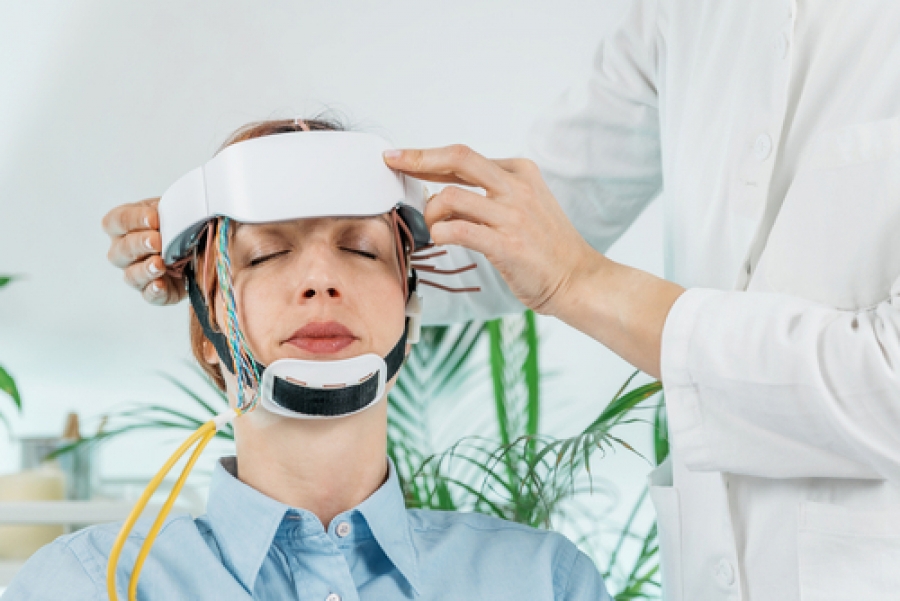In order to receive proper care for your mental health condition, it’s important to have an idea of what neurofeedback is and its purpose. When looking for a neurofeedback clinic near you, you may have some unresolved questions about the process and the treatment. To assist your search, we have created a complete rundown of what neurofeedback is.
Defining Neurofeedback
Neurofeedback, also known as EEG biofeedback, belongs to a group of therapies called biofeedback. Biofeedback therapies help people view their bodily functions in real time so that they can gain greater control over those functions.
Biofeedback is used to measure physiological responses in real-time and then, through repeated exposure, train to return those responses to normal ranges. This therapy may be used to measure stress levels, muscle tension, skin temperature, heart rate variability (HRV), and blood pressure. Biofeedback has been used to help people who suffer from various conditions including anxiety, asthma, stress, migraine headaches, and chronic backaches.
Neurofeedback, on the other hand, measures brainwave activity, which is then used to train the brain. The neurofeedback process involves placing EEG electrodes on the scalp, hence its name is “EEG biofeedback”.
Neurofeedback aims to train the human mind to self-regulate its own activity. It helps people learn when they’ve achieved their desired mental state. After repeated training sessions, patients can begin to control their cognitive behaviors and brainwave activity without being monitored.
What Are Brainwaves?
Our brains work like radio stations, broadcasting information throughout our bodies. Brainwaves are signals traveling across the brain that help us think, learn, remember, and feel emotions. They occur in cycles, moving from slow waves to rapid waves over time. There are four main types of brainwaves:
-
Delta
-
Theta
-
Alpha
-
Beta
Delta waves are the lowest frequency brainwaves, occurring at 0.5 Hz to 3 Hz. Alpha waves are the next highest, occurring at 8–12 Hz. Beta waves are some of the fastest, occurring at 13–30 Hz. And Gamma waves are even faster, occurring at 30+ Hz.
The human brain produces different kinds of brain waves depending on what we’re doing. For example, during REM sleep, we experience a greater volume of theta waves as the low frequencies help make us dream. During waking hours, however, we produce more alpha waves, which are associated with relaxed states such as meditation and daydreaming. When we pay attention to something, we experience increases in beta wave activities, which are associated both with focused concentration and increased energy levels. Finally, when we fall asleep, we enter into delta waves, which are associated primarily with dreaming and memory consolidation.
What Can Neurofeedback Treat?
Mental Disorders
Neurofeedback training can help people learn how to reduce excessive fast beta waves (associated with anxiety) and increase alpha waves (associated with calming down). In fact, neurofeedback can help treat mental health issues such as anxiety, depression, OCD, and PTSD.
Behavior and Developmental Disorders
Many developmental disorders cause the brain to fail to develop the proper neural pathways for communicating. Neurofeedback can significantly change neural activity patterns as measured by functional magnetic resonance imaging (fMRI) and improve behavioral outcomes in patients with ASDS, attention deficiency (ADHD), or PANS/PANDAS.
Neurological Issues and Brain Injury
Neurological issues are some of the most common reasons people seek out alternative therapies, including neurofeedback. These include traumatic brain injury (TBI), stroke, tinnitus (ringing in the ears), and Parkinson’s disease, among others. Neurofeedback is one of many complementary treatments used to treat neurological disorders, and it helps these individuals by training patients’ brains to self-regulate.
For example, one study found that neurofeedback helped reduce tinnitus severity. Another showed significant improvements in attention deficit hyperactivity disorder (ADHD). And another demonstrated that neurofeedback could help alleviate chronic pain as well.
Finding a Neurofeedback Clinic Near Me
Now you have an idea of what neurofeedback is and what it can treat, it’s time to find a neurofeedback clinic near you in Denver. In order to find the right neurofeedback clinic for you, it’s important to look at the experience of each nearby clinic and carefully weigh your options depending on your schedule and flexibility.
At Braincode Centers, we are one of the leading neurofeedback practitioners in the Denver metro area and we build customized treatment plans for every patient we work with. To learn more about our neurofeedback at Braincode Centers, contact us today.

